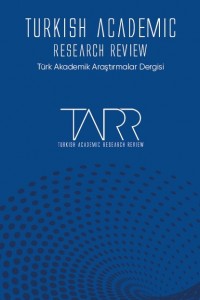Öz
Anahtar Kelimeler
Rhinoceros Rhinocerisation Transformation Theatre of the Absurd Eugène Ionesco
Kaynakça
- Craddock, George E., Jr. (1971). Escape and Fulfilment in the Theatre of Eugène Ionesco. The Southern Quarterly, 10, 15-22.
- Dolamore, C. E. J. (1984). Ionesco: “Rhinoceros”: Critical Guides to French Texts S. London: Grant & Cutler Ltd.
- Ekberg, Jeremy (2011). Ontological Empowerment: Embodiment and Essence in the Theatre of the Absurd. Unpublished doctoral dissertation. The University of Alabama, Tuscaloosa.
- Esslin, Martin (1960). The Theatre of the Absurd. The Tulane Drama Review, 4(4), 3-15. Doi:10.2307/1124873
- Esslin, Martin (2001). The Theatre of the Absurd. 3rd. Ed. New York: Vintage Books.
- Fowlie, Wallace (1960). New Plays of Ionesco and Genet. The Tulane Drama Review, 5(1), 43-48. Doi:10.2307/1124901
- Guppy, Shusha (1984). Eugène Ionesco: The Art of the Theater no. 6: Interviewed by Shusha Guppy. The Paris Review, 93. https://www.theparisreview.org/interviews/2956/the-art-of-theater-no-6-eugene-ionesco
- Haney, William S. II. (2008). Eugène Ionesco’s Rhinoceros: Defiance vs. Conformity. Interactions. 17(1), 85-101.
- Ionesco, Eugène (1960). Rhinoceros. Rhinoceros and Other Plays. Trans. Derek Prouse. New York: Grove.
- Lane, Nancy (1994). Understanding Eugène Ionesco. Columbia: University of South Carolina Press.
- Morgan, Margot Bonel (2010). The Decline of Political Theatre in 20th Century Europe: Shaw, Brecht, Sartre, and Ionesco Compared. Unpublished Doctoral Dissertation. The State University of New Jersey, Rutgers.
- Murray, Jack (1962). Ionesco and the Mechanics of Memory. Yale French Studies, 29, 82-87. Doi:10.2307/2929038
- Quinney, A. (2007). Excess and Identity: The Franco-Romanian lonesco Combats Rhinoceritis. South Central Review, 24(3), 36-52. http://www.jstor.org/stable/40040007
- Strem, George G. (1962). Ritual and Poetry in Eugène Ionesco’s Theatre. Texas Quarterly, 5(4), 149-158.
- Valentine, John M. (2011). Kitsch and the Absurd in Eugène Ionesco’s Rhinoceros. Florida Philosophical Review, 11(1), 54-65.
- Thomson, Peter. (1970). Games and Plays: An Approach to Ionesco. Educational Theatre Journal, 22(1), 60-70. Doi:10.2307/3205501
- Williams, Edwin T. (1962). Cervantes and Ionesco and Dramatic Fantasy. Hispania, 45(4), 675-678. Doi:10.2307/337349
Öz
Anahtar Kelimeler
Gergedanlar Gergedanlaşma Dönüşüm Absürt Tiyatro Eugène Ionesco
Kaynakça
- Craddock, George E., Jr. (1971). Escape and Fulfilment in the Theatre of Eugène Ionesco. The Southern Quarterly, 10, 15-22.
- Dolamore, C. E. J. (1984). Ionesco: “Rhinoceros”: Critical Guides to French Texts S. London: Grant & Cutler Ltd.
- Ekberg, Jeremy (2011). Ontological Empowerment: Embodiment and Essence in the Theatre of the Absurd. Unpublished doctoral dissertation. The University of Alabama, Tuscaloosa.
- Esslin, Martin (1960). The Theatre of the Absurd. The Tulane Drama Review, 4(4), 3-15. Doi:10.2307/1124873
- Esslin, Martin (2001). The Theatre of the Absurd. 3rd. Ed. New York: Vintage Books.
- Fowlie, Wallace (1960). New Plays of Ionesco and Genet. The Tulane Drama Review, 5(1), 43-48. Doi:10.2307/1124901
- Guppy, Shusha (1984). Eugène Ionesco: The Art of the Theater no. 6: Interviewed by Shusha Guppy. The Paris Review, 93. https://www.theparisreview.org/interviews/2956/the-art-of-theater-no-6-eugene-ionesco
- Haney, William S. II. (2008). Eugène Ionesco’s Rhinoceros: Defiance vs. Conformity. Interactions. 17(1), 85-101.
- Ionesco, Eugène (1960). Rhinoceros. Rhinoceros and Other Plays. Trans. Derek Prouse. New York: Grove.
- Lane, Nancy (1994). Understanding Eugène Ionesco. Columbia: University of South Carolina Press.
- Morgan, Margot Bonel (2010). The Decline of Political Theatre in 20th Century Europe: Shaw, Brecht, Sartre, and Ionesco Compared. Unpublished Doctoral Dissertation. The State University of New Jersey, Rutgers.
- Murray, Jack (1962). Ionesco and the Mechanics of Memory. Yale French Studies, 29, 82-87. Doi:10.2307/2929038
- Quinney, A. (2007). Excess and Identity: The Franco-Romanian lonesco Combats Rhinoceritis. South Central Review, 24(3), 36-52. http://www.jstor.org/stable/40040007
- Strem, George G. (1962). Ritual and Poetry in Eugène Ionesco’s Theatre. Texas Quarterly, 5(4), 149-158.
- Valentine, John M. (2011). Kitsch and the Absurd in Eugène Ionesco’s Rhinoceros. Florida Philosophical Review, 11(1), 54-65.
- Thomson, Peter. (1970). Games and Plays: An Approach to Ionesco. Educational Theatre Journal, 22(1), 60-70. Doi:10.2307/3205501
- Williams, Edwin T. (1962). Cervantes and Ionesco and Dramatic Fantasy. Hispania, 45(4), 675-678. Doi:10.2307/337349
Ayrıntılar
| Birincil Dil | İngilizce |
|---|---|
| Konular | Sanat ve Edebiyat |
| Bölüm | Makaleler |
| Yazarlar | |
| Yayımlanma Tarihi | 25 Mart 2021 |
| Yayımlandığı Sayı | Yıl 2021 Cilt: 6 Sayı: 1 |



